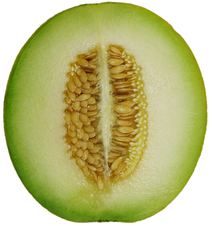Melon ( Cucums melo L. )
 Melons originated in Africa[5] and southwest Asia,[6] but they gradually began to appear in Europe toward the end of the Roman Empire. Melons were among the earliest plants to be domesticated in both the Old and New Worlds.[7] Early European settlers in the New World are recorded as growing honeydew and casaba melons as early as the 1600s.[6] A number of Native American tribes in New Mexico, including Acoma, Cochiti, Isleta, Navajo, Santo Domingo and San Felipe, maintain a tradition of growing their own characteristic melon cultivars, derived from melons originally introduced by the Spanish. Organizations like Native Seeds/SEARCH have made an effort to collect and preserve these and other heritage seeds.[8]
Melons are a nutritious food. The seeds of cantaloupe were used in China to moderate fevers and the digestive system. Elsewhere[where?], seeds were ground into a powder and used to treat tuberculosis. They have high levels of potassium. Due to their high water content, all melons are considered diuretics.[citation needed]
There is also evidence that suggests that eating melons can lower the risk of cancer[citation needed]. USDA researchers discovered that melons have lycopene, an antioxidant found in a select group of fruits and vegetables.
Melons originated in Africa[5] and southwest Asia,[6] but they gradually began to appear in Europe toward the end of the Roman Empire. Melons were among the earliest plants to be domesticated in both the Old and New Worlds.[7] Early European settlers in the New World are recorded as growing honeydew and casaba melons as early as the 1600s.[6] A number of Native American tribes in New Mexico, including Acoma, Cochiti, Isleta, Navajo, Santo Domingo and San Felipe, maintain a tradition of growing their own characteristic melon cultivars, derived from melons originally introduced by the Spanish. Organizations like Native Seeds/SEARCH have made an effort to collect and preserve these and other heritage seeds.[8]
Melons are a nutritious food. The seeds of cantaloupe were used in China to moderate fevers and the digestive system. Elsewhere[where?], seeds were ground into a powder and used to treat tuberculosis. They have high levels of potassium. Due to their high water content, all melons are considered diuretics.[citation needed]
There is also evidence that suggests that eating melons can lower the risk of cancer[citation needed]. USDA researchers discovered that melons have lycopene, an antioxidant found in a select group of fruits and vegetables.




